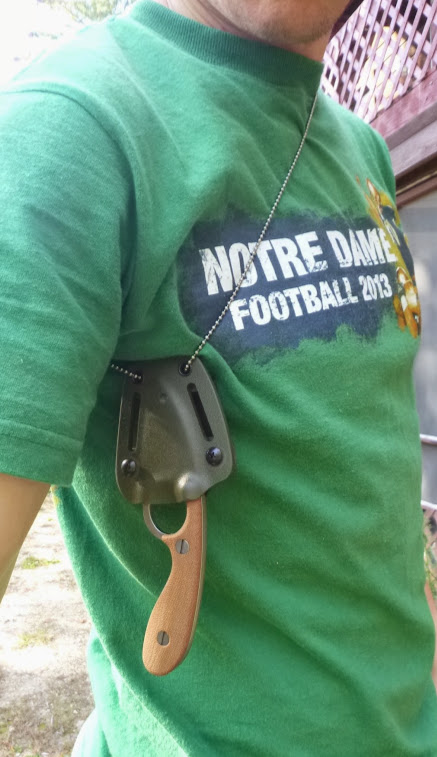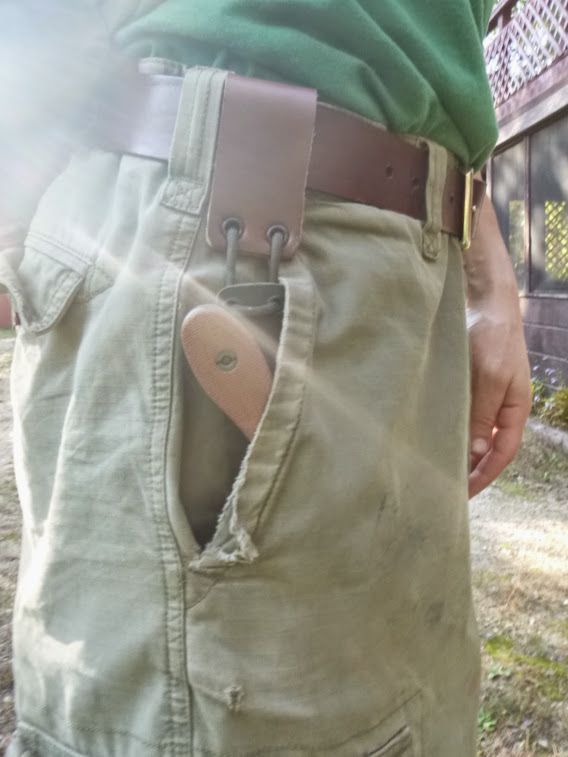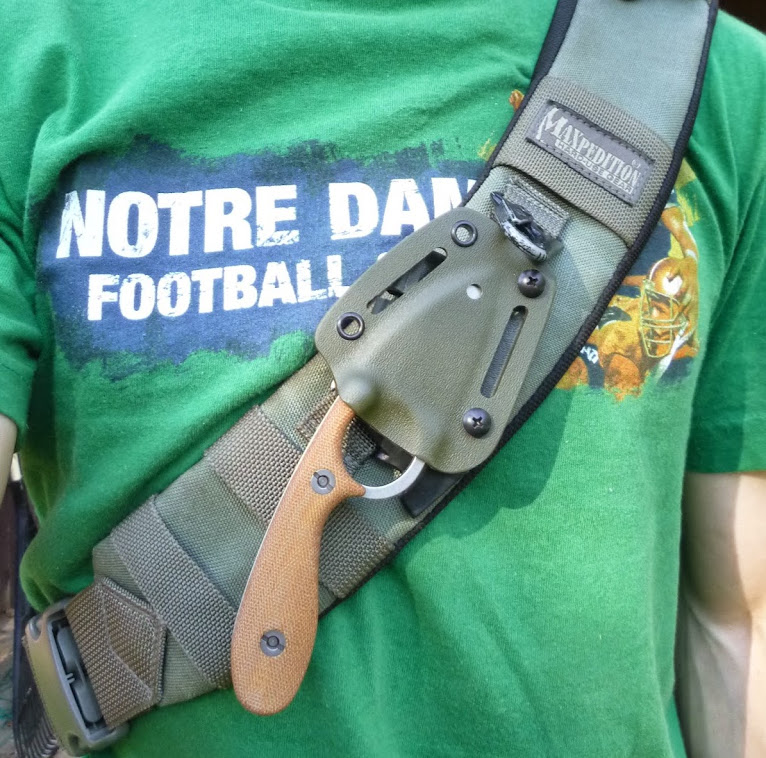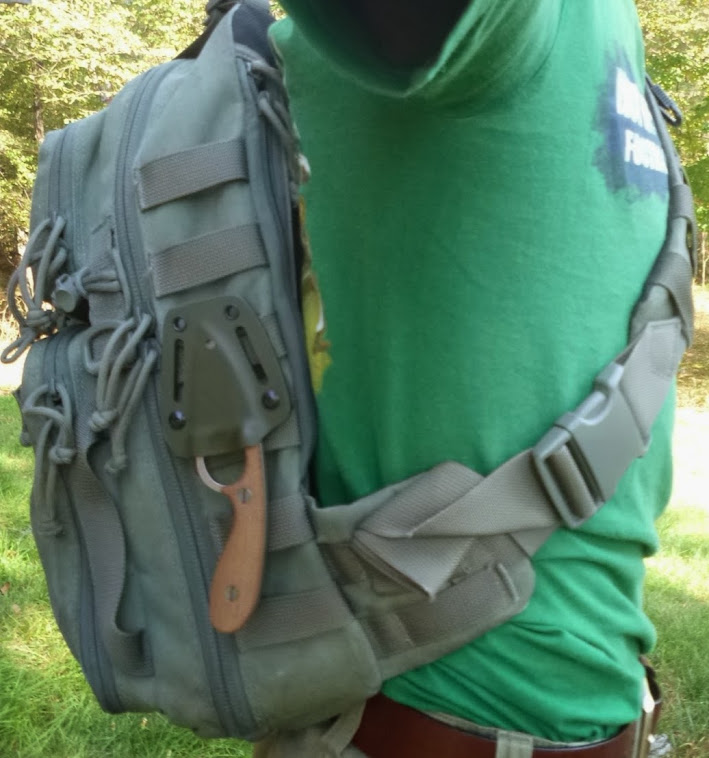chiral.grolim
Universal Kydex Sheath Extension
- Joined
- Dec 2, 2008
- Messages
- 6,422
Survive! Knives GSO Necker II - Review and Comparison with photos
Guy Seiferd's neck-knife design was originally released as a minimal cutting tool with a stout little sheepsfoot ring-blade and short tang to which a lanyard would be strapped for higher retention:



That design was modified slightly and is still available from the S!K website: http://surviveknives.com/knives/gso-series/necker.html
Popular demand was for a full-handle version of the knife, the Necker II: http://surviveknives.com/knives/gso-series/necker-ii.html



Specs:
Length: 2.25" Blade (tip to choil cutting edge) + 0.15" choil + 4.12" Handle = ~6.5" OAL
Blade Width: 0.5" saber-flat + 0.83" flat primary bevel + 0.04" edge bevel = 1.37" above the choil, dropping to the point.
Thickness: 0.156" stock down 4.5dps to 0.025" edge bevel, ~20dps
Handle width/thickness: 0.6" x ~1" palm, ring-hole 1.15 x 0.95. Skeletonized tang with hidden lanyard hole.
Blade material: Crucible CPM-20CV hardened/tempered to 58-59 Rc by Peter's Heat Treat, stonewashed finish.
Handles: rough canvas micarta (other options available)
Weight: 3.45 oz, 5.15 with sheath
At 0.156" stock thickness and 0.025" edge thickness, this is a stout little knife! Like a cut-down version of the GSO-4.1. The thick spine does provide plenty of platform for a lot of thumb pressure, it features the same well-done jimping - series of 1/16" valleys and plateaus - that provide excellent traction without being uncomfortable, and thickness is maintained to within an inch of the tip, providing a lot of strength for prying.



Finishing along the spine/belly was smoother on this knife than any other GSO I've recieved, the cutting-marks only visible within the ring. The edges of the spine and ring are slightly rounded for comfort :thumbup: so you won't be striking your firesteel without a dedicated scraper.
The ring is more comfortable than might be expected, plenty large for even my heavy work gloves, though I admit to being unaccustomed to such a design, prefering my middle and index fingers to make full contact and to have more material under my index finger for control. But the ring does add a measure of security - as an integral guard, no way your finger is slipping onto the blade and you can also let go the handle to use your fingers for other activities such as tying rope in a knot or tugging at the innards of an animal being dressed, etc. The sheepsfoot blade isn't designed for piercing but works quite well for gutting and skinning with its dramatic drop-point and that slight belly-curve :thumbup:
and you can also let go the handle to use your fingers for other activities such as tying rope in a knot or tugging at the innards of an animal being dressed, etc. The sheepsfoot blade isn't designed for piercing but works quite well for gutting and skinning with its dramatic drop-point and that slight belly-curve :thumbup:






The rough micarta handle scales are well affixed with aligned screw-heads (another Survive! trademark? ) and the surface provides excellent traction in wet or dry conditions. The scales are surprisingly well designed, providing added thickness at the spine and contoured around the ring to distribute pressure and aid in indexing and control. :thumbup::thumbup:
) and the surface provides excellent traction in wet or dry conditions. The scales are surprisingly well designed, providing added thickness at the spine and contoured around the ring to distribute pressure and aid in indexing and control. :thumbup::thumbup:
This thickness is maintained as the handle curves into the pocket of the hand, ends with a well-rounded pommel. This time there is no heel-flare to cause discomfort as on the GSO-4.1. The handle returns to the index-ring with a similar curve but is tapered along the belly so the last two fingers can more easily grasp the end, then it widens to full thickness for the middle-finger seated just below the ring. This is a reeaaly well thought-out handle. Even the nibs just below the blade are well-designed - curved for comfort and still thick enough to provide a platform for your fingers in a forward pinch-grip. The design accommodates numerous hand positions beyond simple use of the ring. The knife balances casually on the middle-finger grooves just below the ring.



The steel is CPM-20CV, Crucible's version of M390, with 1.9% Carbon and 4% Vanadium along with 1% molybdenum and 0.6% tungsten for carbides, 20% chromium to pick up the rest and offer excellent corrosion resistance besides. S!K lists the steel as hardened to 58-59Rc which may be a bit soft but they do use Peter's HT who are well respected for what they do. Ankerson here on bladeforums put similar M390 through is edge-retention regime: http://www.bladeforums.com/forums/s...based-on-Edge-Retention-cutting-5-8-quot-rope
Needless to type, this is "high-end" steel.

The sheath:
Once again kydex-bender Kiah proves to be an asset to be Survive! Knives. I consider his work second to none. The sheath is constructed of 0.093" kydex with a seamless 'pancake' design and chamfered edges for comfort, is ambidextrous with a multi-positionable MOLLE-compatible G-clip for attachment to a 2" belt (or less) or pocket, waist-band, gear-webbing, etc.




The sheath is well formed for a VERY secure fit. One criticism - you may want to route-out the mouth a bit to accept the blade more easily when re-sheathing. There is absolutely no rattle and no fear of the knife coming loose without a deliberate tug. Enough of the ring is left exposed to make for easy deployment, a thumbramp is incorporated for further facilitation. It features a small 'weep-hole' on either side for moisture and cleaning but is otherwise maintenance free and very durable. The slots allow not only alternate positioning of the clip but also use of straps, cord, a tek-lok or an extension, etc. Or you can remove the clip and use the provided break-away bead-chain for neck-carry. Again, for the price it is hard to find a better built, better designed sheath :thumbup::thumbup:










With the extension piece I make that fits all Survive! knives:



On a Maxpedition Sitka (among the most versatile packs on the market, imho :thumbup :
:




The Necker II costs ~$145 (including shipping) right now, with a variety of sheath and handle-scale options/upgrades. This is not an inexpensive knife, but it shows in the design, materials, construction, and even the sheath. It is a tough knife built to handle rough outdoor use while requiring little in the way of maintenance in any environment. It also has a rather unique look...
Guy Seiferd's neck-knife design was originally released as a minimal cutting tool with a stout little sheepsfoot ring-blade and short tang to which a lanyard would be strapped for higher retention:
That design was modified slightly and is still available from the S!K website: http://surviveknives.com/knives/gso-series/necker.html
Popular demand was for a full-handle version of the knife, the Necker II: http://surviveknives.com/knives/gso-series/necker-ii.html
Specs:
Length: 2.25" Blade (tip to choil cutting edge) + 0.15" choil + 4.12" Handle = ~6.5" OAL
Blade Width: 0.5" saber-flat + 0.83" flat primary bevel + 0.04" edge bevel = 1.37" above the choil, dropping to the point.
Thickness: 0.156" stock down 4.5dps to 0.025" edge bevel, ~20dps
Handle width/thickness: 0.6" x ~1" palm, ring-hole 1.15 x 0.95. Skeletonized tang with hidden lanyard hole.
Blade material: Crucible CPM-20CV hardened/tempered to 58-59 Rc by Peter's Heat Treat, stonewashed finish.
Handles: rough canvas micarta (other options available)
Weight: 3.45 oz, 5.15 with sheath
At 0.156" stock thickness and 0.025" edge thickness, this is a stout little knife! Like a cut-down version of the GSO-4.1. The thick spine does provide plenty of platform for a lot of thumb pressure, it features the same well-done jimping - series of 1/16" valleys and plateaus - that provide excellent traction without being uncomfortable, and thickness is maintained to within an inch of the tip, providing a lot of strength for prying.
Finishing along the spine/belly was smoother on this knife than any other GSO I've recieved, the cutting-marks only visible within the ring. The edges of the spine and ring are slightly rounded for comfort :thumbup: so you won't be striking your firesteel without a dedicated scraper.
The ring is more comfortable than might be expected, plenty large for even my heavy work gloves, though I admit to being unaccustomed to such a design, prefering my middle and index fingers to make full contact and to have more material under my index finger for control. But the ring does add a measure of security - as an integral guard, no way your finger is slipping onto the blade
The rough micarta handle scales are well affixed with aligned screw-heads (another Survive! trademark?
This thickness is maintained as the handle curves into the pocket of the hand, ends with a well-rounded pommel. This time there is no heel-flare to cause discomfort as on the GSO-4.1. The handle returns to the index-ring with a similar curve but is tapered along the belly so the last two fingers can more easily grasp the end, then it widens to full thickness for the middle-finger seated just below the ring. This is a reeaaly well thought-out handle. Even the nibs just below the blade are well-designed - curved for comfort and still thick enough to provide a platform for your fingers in a forward pinch-grip. The design accommodates numerous hand positions beyond simple use of the ring. The knife balances casually on the middle-finger grooves just below the ring.
The steel is CPM-20CV, Crucible's version of M390, with 1.9% Carbon and 4% Vanadium along with 1% molybdenum and 0.6% tungsten for carbides, 20% chromium to pick up the rest and offer excellent corrosion resistance besides. S!K lists the steel as hardened to 58-59Rc which may be a bit soft but they do use Peter's HT who are well respected for what they do. Ankerson here on bladeforums put similar M390 through is edge-retention regime: http://www.bladeforums.com/forums/s...based-on-Edge-Retention-cutting-5-8-quot-rope
Needless to type, this is "high-end" steel.

The sheath:
Once again kydex-bender Kiah proves to be an asset to be Survive! Knives. I consider his work second to none. The sheath is constructed of 0.093" kydex with a seamless 'pancake' design and chamfered edges for comfort, is ambidextrous with a multi-positionable MOLLE-compatible G-clip for attachment to a 2" belt (or less) or pocket, waist-band, gear-webbing, etc.
The sheath is well formed for a VERY secure fit. One criticism - you may want to route-out the mouth a bit to accept the blade more easily when re-sheathing. There is absolutely no rattle and no fear of the knife coming loose without a deliberate tug. Enough of the ring is left exposed to make for easy deployment, a thumbramp is incorporated for further facilitation. It features a small 'weep-hole' on either side for moisture and cleaning but is otherwise maintenance free and very durable. The slots allow not only alternate positioning of the clip but also use of straps, cord, a tek-lok or an extension, etc. Or you can remove the clip and use the provided break-away bead-chain for neck-carry. Again, for the price it is hard to find a better built, better designed sheath :thumbup::thumbup:
With the extension piece I make that fits all Survive! knives:
On a Maxpedition Sitka (among the most versatile packs on the market, imho :thumbup
The Necker II costs ~$145 (including shipping) right now, with a variety of sheath and handle-scale options/upgrades. This is not an inexpensive knife, but it shows in the design, materials, construction, and even the sheath. It is a tough knife built to handle rough outdoor use while requiring little in the way of maintenance in any environment. It also has a rather unique look...
